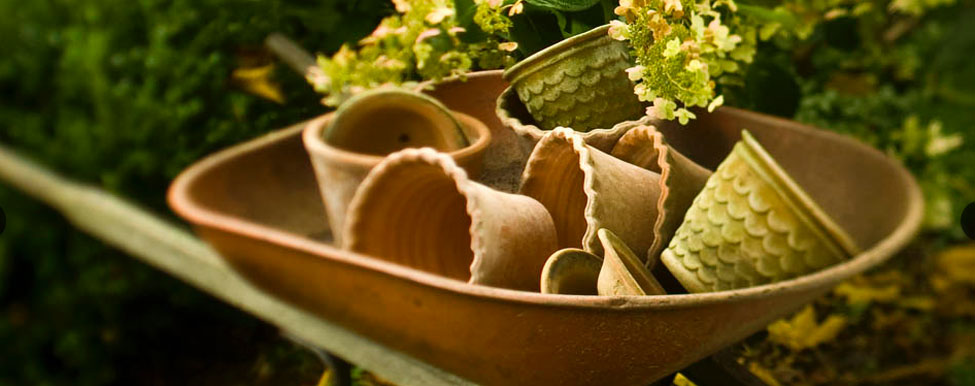Campo de' Fiori
“My nickname in horticultural circles is Agent Orange, for my pruning techniques,” says Barbara with her signature raised eyebrow to the camera. She continues pruning the jasmine with stylish abandon, down to its barest signs of life.
“Just a bit of HH, you know,” she says wryly. After the pause: “horticultural humor.” She pushes what look suspiciously like socks with the foot part cut off over several large silver bracelets on her wrists, roughly grabs a large San Remo urn and plunks it down in front of her. “Ok. Next video!”
This was the scene at Campo de’ Fiori in Sheffield recently on a day when some gardening videos were being shot for the website. Light flooded the upstairs floor, reminiscent of an old hayloft, onto several of Campo’s unmistakable mossed terra cotta pots, foliage spilling over the edges. To one side an old mesquite table was littered with plant cuttings. Piles of books, bronze critters and elegant little naturally-inspired objets sat artfully atop soap dishes and stone urns.
Some footsteps thudded up the stairs and a bearded figure in a wool vest and jeans, a braid trailing down his back, part Edwardian gentleman, part Native American elder, appeared, grooming his impressive moustaches. “How goes it?”
The phone rings and Robin ambles back downstairs and takes the call from the factory in Mexico in the store, speaking elegant Spanish rapid-fire into the phone.
Robin and Barbara Norris, husband and wife team behind the mossed pots on display here, share what these days amounts to a quaint disdain for self-promotion. “We just do what we’ve always done, make stuff we like,” says Robin. “I want no part of trends. I despise trends. You can forget your Google Analytics, whatever that is.”
Barbara sweeps by, a mammoth spray of forsythia grazing everything in her wake. “Coming through!” She is putting old stuff in the compost and getting new plants out of the greenhouse and into the store. Forced blue and purple hydrangea burst on your attention as soon as you walk in. Baby hyacinths peep out of a zinc planter next to it a stone pot with the tiniest daffodils you’ve ever seen. It’s twenty-five degrees outside but these precious little beauties have just emerged from the greenhouse. A cherub pours water from a stone saucer into a fountain.
Robin and Barbara’s aesthetic is irresistible for a certain type of person drawn to earthy country living, enamored of the outdoors and unafraid of manual labor. There is almost nothing that looks new or modern in their home—grey old vacuum cleaners, yellowed food processors from the ‘80s, antique utensils—but it all works. And it amounts to a feeling, almost a frequency, you experience there. The air is distinctly still, free from the electronic thrum we have become so inured to. You will want to flop down on the sofa next to the wood stove and read one of the many books or magazines lying around: “Mushrooms Demystified,” for example. Perhaps Barbara will bring you some of her delicious homemade tea, made from herbs she grew or foraged. Then you can talk politics or physics with Robin in any number of the four languages he speaks fluently.
At the end of the evening you will feel more centered somehow.
While countless gardeners and aesthetic types drawn to a more earthbound life in the Berkshires revere her, it isn’t any kind of attention she’s after. Barbara’s aesthetic is woven into everything she does, a seamless part of who she is. She pursues beauty in the natural world as one pursues any cherished and deeply felt goal—with single-minded focus and intent. She and Robin feel best rooted to the earth, and to place—their home, a converted barn they built in Alford. There they are surrounded by Barbara’s gorgeous plantings, the art and objets collected over countless trips to Mexico and Robin’s peripatetic life in Europe and later, Indian country.
The business, Campo de’ Fiori, is a reflection of their life choices and values. They make beautiful mossed pots for the garden, quirkily delightful stone sculptures of animals and others, bronze garden accents and lots of other oddball stuff. Most products are made in their factory in Mexico by artisans they have known personally for decades. All the products are made of natural materials that, as Robin says, “return quietly to the earth whence they came.' Because, like the Indians say,' the greatest legacy is to leave no trace at all.’”

